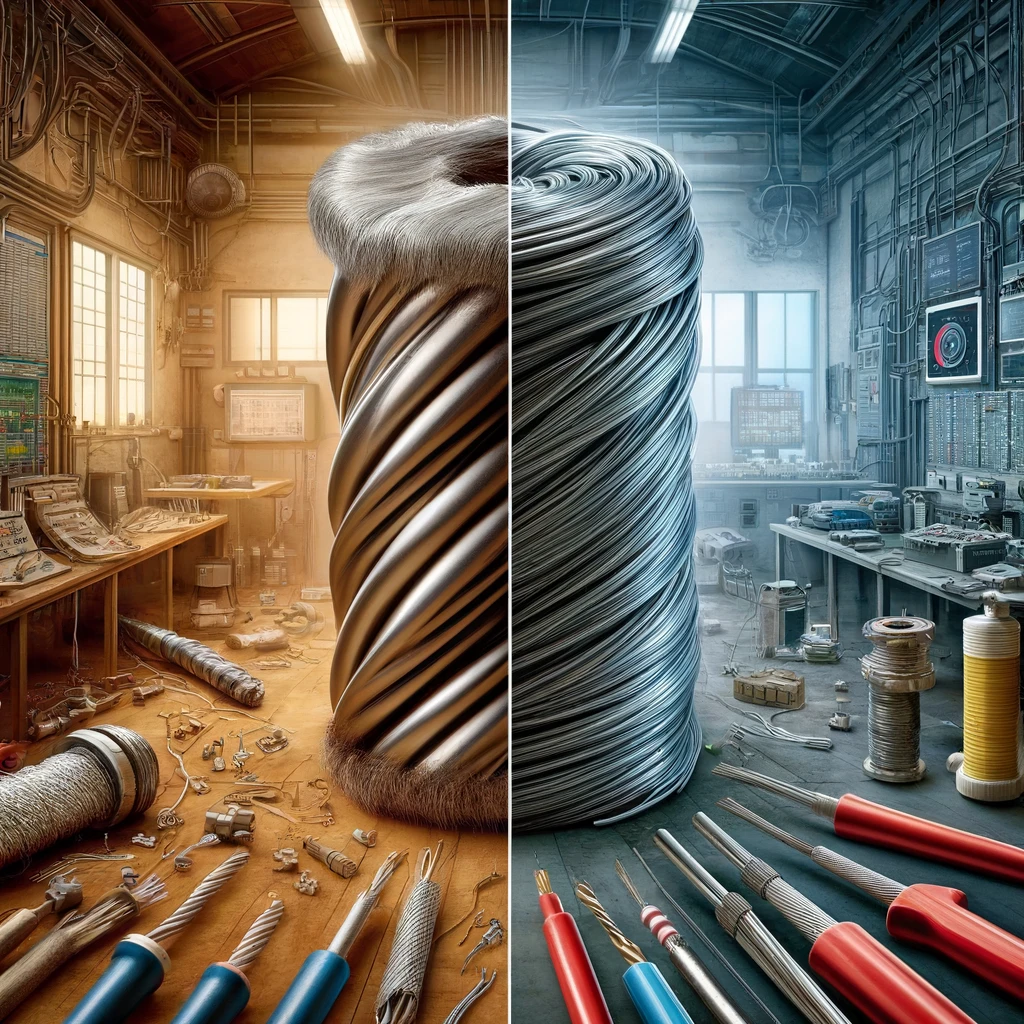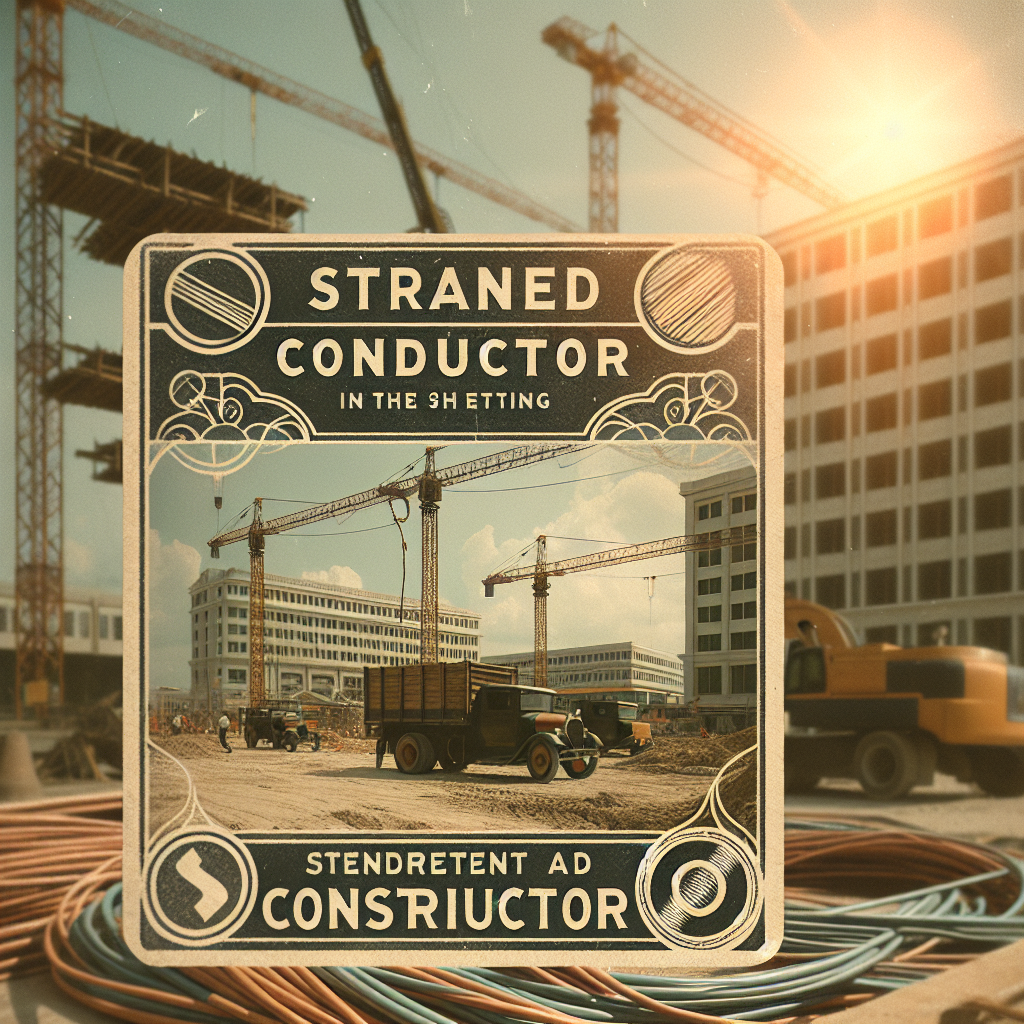Introduction to Conductors in Construction
Ever wondered about the intricate details behind the wiring in your home, office, or the machines you use daily?
The answer lies in the type of conductors used. In this blog post, we will take you through the world of conductors used in construction, specifically focusing on stranded and solid conductors.
We’ll dive into their definitions, characteristics, types, and practical uses.
Our journey will not stop there. We will also explore the key factors that influence the choice of conductors, along with the pros and cons of each type. Also, a handy comparison section is added for a quick understanding of the primary differences.
Ready to unlock the secret world of wires? Let’s get started on this article!
Table of Contents
Stranded Conductor in Construction

Definition of a Stranded Conductor
A stranded conductor refers to a type of electrical cable composed of multiple smaller wires or strands. Unlike a solid wire composed of a single piece of metal, a stranded conductor enhances flexibility without compromising conductivity, making it ideal for complex construction projects.
Key Characteristics of Stranded Conductors
Flexibility
A noteworthy quality of stranded conductors is their high degree of flexibility. The cable’s configuration comprises multiple smaller strands, which allows for easy bends and twists. This flexibility is particularly advantageous in construction applications where wires need to navigate around corners or through tight spaces.
Conductivity
Stranded conductors don’t sacrifice conductivity for flexibility. Because these wires comprise multiple strands tightly bundled together, they provide a large surface area for electrical transmission, ensuring efficient power transfer.
Types of Stranded Conductors in Construction
There is a range of stranded conductors used in construction, encompassing:
- Bunch Stranding: In this format, wires are twisted together in the same direction without a predetermined pattern.
- Unilay Stranding: Here, one central wire is surrounded by an even number of surrounding wires, all laid in the same direction.
- Concentric Stranding: This involves a central wire surrounded by layers of additional wires, with each layer laid in the opposite direction to the one beneath it.
Practical Uses of Stranded Conductors in Construction
Stranded conductors prove beneficial in various applications in the construction industry. They’re commonly used in building wiring, appliance wiring, and portable tools as they can handle dynamic stress and constant movement. For example, they are ideal for wiring appliances like refrigerators and ovens, where wires can be exposed to constant movement.
For more concrete information on stranded conductors and their uses, the National Fire Protection Association’s guide on electrical safety in residential constructions provides a comprehensive overview.
Factors Influencing the Choice of Stranded Conductors
Environment and Application
The surrounding environment and the intended application of the cables play a significant role in determining the type of stranded conductor to use. Places with high vibration or constant movement like certain machinery and electrical devices require stranded wires for their increased flexibility and resistance to metal fatigue. The same applies to projects where wires need to mold around corners or move through tight spaces, such as in old building renovations.
Strand Count and Gauge
Another factor to consider when choosing stranded conductors is the strand count and wire gauge. Conductors with a higher strand count are more flexible and more adept at withstanding constant or extreme movement. The strand gauge, on the other hand, affects the overall cable size and the amount of current it can carry.
Advantages of Using Stranded Conductors
Increased Surface Area
Thanks to their multiple strand construction, stranded conductors tend to have a larger surface area compared to their solid counterparts. This increased surface area allows them to carry high-frequency signals more efficiently and with less loss.
Fatigue Resistance
Stranded conductors are highly resistant to work hardening or metal fatigue. In environments where the wires are subjected to repeated movement and bending, the strain is distributed over various strands instead of a single, solid wire. This feature reduces the risk of wire breakage over time.
Easier Installation
The enhanced flexibility of stranded conductors often results in a smoother and faster installation process. This benefit is especially notable in complex construction projects where wires must be bent or maneuvered through tight or convoluted spaces.
Disadvantages of Using Stranded Conductors
Expense and Size
Despite their multiple advantages, stranded conductors do have some downfalls. They are usually more expensive and slightly larger than solid wires of equal conductivity. However, their increased flexibility and fatigue resistance often outweigh these potential drawbacks in specific applications.
Skin Effect
Stranded conductors also suffer from the “skin effect” more than solid conductors. This term refers to the tendency of alternating current (AC) to flow mostly around the outer surface of the conductor rather than uniformly throughout the cross-section. The effect is more pronounced at higher frequencies, causing increased resistance and power loss.
For more in-depth information about the skin effect and how it impacts stranded conductors, this detailed article from the Institute of Electrical and Electronics Engineers (IEEE) can provide additional insights.
Understanding Solid Conductors

Definition of a Solid Conductor
A solid conductor, as opposed to a stranded conductor, comprises a single piece of metal wire, primarily copper or aluminum. This type of conductor is frequently used in electrical wiring where flexibility is not a critical requirement.
Main Characteristics of Solid Conductors
Strength and Resistance
Solid conductors are known for their high tensile strength and resistance to corrosion. These attributes make them a reliable choice for permanent installations where the conductor is not expected to flex or move around.
Lossless Transmission
Another benefit of solid conductors is their efficient transmission of electrical signals. Because they suffer less from the skin effect that can plague stranded conductors, they ensure excellent low-frequency signal transmission.
Types of Solid Conductors
Just as with stranded conductors, there are several types of solid conductors used in different applications:
- Single Solid Conductor: This conductor consists of a single solid wire and is often used for telecommunication lines and data cables.
- Twin Solid Conductor: This type includes two insulated solid conductors, typically used in applications like lighting and small appliances.
- Cat5/Cat6 Ethernet Cable: These cables contain multiple solid conductors and are commonly used for networking and internet connections.
Uses of Solid Conductors
Due to their strength and stability, solid conductors are often used in situations where the wires do not need to be flexible. These include fixed structures like home and office buildings, where the wiring remains stationary after installation. They’re also used in small electronic devices where the conductor’s stability is paramount.
Factors to Consider when Choosing Solid Conductors
Intended Use and Environmental Conditions
When considering a solid conductor, the project’s specifics, such as its stationary nature and the ambient conditions, should be taken into account. Solid conductors are best utilized in environments with minimal movement or vibration.
Cable Size and Gauge
The gauge of the conductor plays a crucial role in determining the local electrical codes’ compliance and the amount of electrical current it can carry. Because solid conductors generally provide less surface area than stranded wires, it is important to ensure they are properly sized for the application.
Advantages of Using Solid Conductors
Cost and Size Efficiency
Solid conductors tend to be more cost-effective and smaller in size than their stranded counterparts. This makes them a popular choice for applications where space is at a premium and affordability is a priority.
Reliability
As a solid single piece of wire, these conductors are less likely to break or damage over time, provided they are not manipulated frequently. This reliability makes solid conductors well suited for long-term electrical installations.
Drawbacks of Utilizing Solid Conductors
Lack of Flexibility
The main disadvantage of solid conductors is their rigidity. They are not designed to withstand repeated bending or flexing, which limits their use in dynamic environments or applications requiring significant movement.
Installation Challenges
Due to their lack of flexibility, solid conductors can be more difficult and time-consuming to install in complex or intricate layouts. They may not be the most suitable choice for environments with many twists and turns in the path of the conductor.
For more information on solid conductors and their applications, consider visiting the Electrical Construction & Maintenance website.
Comparing Stranded and Solid Conductors

When exploring the world of electrical conductors, it can be tricky to understand the key differences between stranded and solid conductor types. In this guide, we’re going to simplify the difference, so you can better understand each one’s unique characteristics, benefits, and drawbacks.
Core Composition
Stranded conductors consist of multiple small strands or wires, offering a high level of flexibility. This feature makes these conductors well-suited for applications that require curved or complex wiring paths. On the contrary, solid conductors are made from a single piece of material, usually copper or aluminum, making them sturdy yet less flexible.
Flexibility and Conformity
A striking difference between stranded and solid conductors involves flexibility. Thanks to the multitude of individual strands, stranded conductors can easily navigate around corners or through complicated wiring routes. Conversely, the solidity of solid conductors makes them rigid and more suitable for straight or permanent installations.
Resistance to Fatigue
In situations requiring repeated movement or bending of wires, stranded conductors have an advantage. Their structure absorbs and distributes strain across the numerous strands, boosting fatigue resistance. Solid conductors, on the other hand, don’t enjoy this structural benefit and thus are more prone to work hardening when subjected to constant flexing or vibrating.
Conductivity
Despite their differing structures, both stranded and solid conductors effectively transmit electrical power. However, stranded conductors have a larger surface area which permits them to carry high-frequency signals efficiently. Solid conductors, while not having the same surface area, still ensure efficient low-frequency signal transmission, thanks to their singular construction and lesser exposure to the “skin effect”.
Choosing the Right Conductor
Dependent on Application
The choice between solid and stranded conductors hinges on the specific application. Dynamic applications, like machinery or portable tools, or winding paths in old building renovations, often call for stranded conductors due to their superior flexibility. Conversely, for non-flexing, permanent installations such as residential or office tower wiring, solid conductors, with their enhanced strength and reliability, usually fit the bill.
Consideration of Power Transmission
Additionally, your choice might depend on the type of power being transmitted. If you need to carry high-frequency signals, stranded conductors with their large surface area are a suitable choice. Conversely, if your project involves low-frequency signal transmission, solid conductors, which are less influenced by the “skin effect,” would serve you well.
You’ll find more detailed insights on this topic at the National Electrical Manufacturers Association.
Concluding Stranded and Solid Conductors
The choice between using stranded and solid conductors significantly depends on the type of electrical project at hand and the power transmission requirements.
Bereft of compromising conductivity, stranded conductors are highly flexible, excellent in dynamic constructions, adaptable around corners and tight spaces and capable of transmitting high-frequency signals effectively.
On the other hand, solid conductors, characterized by rust resistance and high tensile strength, are more reliable for permanent installations without expected flexing or mobility, and efficiently transmit low-frequency signals. Despite their lack of flexibility and potential installation challenges, solid conductors are often more affordable and smaller in size.
Stranded conductors offer numerous advantages that often outweigh their elevated cost, potential size inconveniences, and susceptibility to the “skin effect”. To decide on the most suitable conductor for a project, careful consideration of the project specifications, planned conductor movement (if any), and efficiency in power transmission is critical.
Frequently Asked Questions – FAQs
What’s the key difference between stranded and solid conductors?
Stranded conductors offer a high level of flexibility due to their composition of multiple small strands, while solid conductors, made of a single piece of metal are less flexible but sturdy.
When should I use a stranded conductor?
Stranded conductors are best for dynamic applications requiring high flexibility and resistance to metal fatigue, such as wiring in machinery or complicated paths in renovations.
When would a solid conductor be the best choice?
Solid conductors are ideal for stationary, permanent installations where high tensile strength and reliability are paramount, and flexibility is not critical.
Do stranded and solid conductors differ in conductivity?
Despite their differing structures, both stranded and solid conductors effectively transmit electric power. However, stranded conductors are more suited for high-frequency signals, and solid conductors ensure efficient low-frequency signal transmission.






